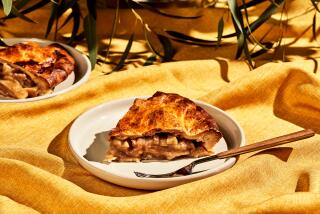Cider Cooking
- Share via
The shacks along the side of country roads that during the summer sold corn, tomatoes and zucchini are now overflowing with early apples. Their aroma reminds you that cooler weather is not far away.
In apple-growing regions of the Northeast and Northwest, in Southern California’s Oak Glen and Julian, in Northern California’s Mendocino County and in the Shenandoah Mountains of Virginia, people get in their cars and drive out to the orchards to buy gallons of fresh cider, unfiltered and unpasteurized.
Apple cider is not a drink that you crave during the hot months. That’s when you need something icy, crisp and quenching. Apple cider is cool-weather fare--not to be drunk too chilled because that diminishes the aroma; it’s sweet and a bit thick, so instead of cooling you off, it fortifies and warms.
You make apple cider by crushing apples, then pressing them to extract all the juice. If filtered and pasteurized, the juice becomes clear and thin--apple juice. When left natural, it is cloudy with the dark honey color of an apple that has browned. Hard ciders, with an alcohol content slightly less than that of wine, are made from one-third sweet apples and two-thirds sour apples. This bubbly drink is only slightly sweet but still has a strong apple aroma.
There are summer apples, fall apples and winter apples. In addition, varieties are classified as eating apples, cooking apples and cider apples. Although we see many fewer varieties than in years past, we eat mostly Red and Yellow Delicious and Pippins--firm, long-lasting varieties. So-called all-purpose apples, best for both eating and cooking, are Spitzenburg, Baldwin, Jonathan, Winesap, McIntosh, Gravenstein, Grimes Golden, Cortland and Rome Beauty.
But autumn brings the best, although somewhat unattractive, crop of cider apples--sweeter and mealier than summer apples, yet with a tart aftertaste. They’re not like the crisper winter crop--the apple aficionados’ apple--crisp, tart and infinitely “apple-y.” The unctuous, unfiltered juice of early fall McIntoshes, Jonathans and the so-called California “ugly” are the best for pressing.
Cider is a traditional autumn drink and, with produce coming from all over the world and at any time of the year, one of the few natural products that we still associate with the change of season.
It’s also a great culinary ingredient. It can be reduced into a concentrated sauce and used to moisten stews or make quick sautes. Because it is sweet, you can combine it in a dish with salty ingredients that balance each other without losing their identities. And, because of its hidden Vitamin C tartness that stabilizes its flavor, cider stands up to cooking, giving up little of its personality.
*
SCALLOPS SAUTEED WITH APPLES AND PANCETTA
1 tablespoon olive oil 1 1/2 pounds small bay scallops or large sea scallops, halved, patted dry Salt 1/4 pound pancetta or bacon, chopped into 1/4-inch pieces 1 teaspoon finely minced shallot 1/2 cup unfiltered apple cider 2 tablespoons butter 1 green Pippin apple, peeled, cut into julienne sticks Pepper
Heat oil in large skillet over high heat. When skillet is very hot and oil almost smoking, toss in scallops without crowding pan, in batches if necessary, and cook 30 seconds without stirring. Then vigorously shake skillet and cook another minute. Season to taste with salt, if desired. Using slotted spoon, remove partially cooked scallops to plate.
Set skillet over medium heat. Add pancetta and shallot and cook, stirring, 1 minute. Add cider and juices that have collected on plate with scallops. Cook until reduced by half. Return scallops to pan and reduce heat to low. Whisk in butter and add apple. Season to taste with salt and pepper. Makes 4 to 6 servings.
*
SAUSAGE, ONIONS AND APPLES
1 medium onion 3 medium Red Delicious apples 8 to 12 assorted fresh sausages (such as spicy Italian, bratwurst and turkey) 1 teaspoon salt Freshly ground pepper 1 tablespoon chopped fresh sage or 1 teaspoon dried 1/2 teaspoon ground coriander 1/4 teaspoon ground mace 1/2 cup apple cider 2 tablespoons chopped parsley Cut onion in half from tip to stem. Lay cut side down and slice thinly from tip to stem.Set aside.
Peel apples and halve from tip to stem. Remove and discard cores. Slice each half thinly. Set aside.
Pierce all sausages except turkey sausages. Place in large skillet over medium heat and cook 3 minutes on each side. Remove from skillet and set aside. Pour off and reserve fat.
Add apples and 2 teaspoons fat to skillet and cook 5 minutes, stirring occasionally. Transfer apples to bowl. Add another teaspoon reserved fat to skillet with onion. Cook, stirring occasionally, 5 minutes. Add contents of skillet to apples.
Place onion and apples in baking dish or oven-proof casserole. Season to taste with salt and pepper. Mix in sage, coriander and mace. Arrange sausages on top and pour in cider. Bake, covered, at 375 degrees 30 minutes. Add parsley and serve piping hot from oven. Makes 4 to 6 servings.
*
HOT BUTTERED APPLE CIDER
1 quart unfiltered apple cider 1 teaspoon whole coriander seeds 1/2 teaspoon ground cardamom or few seeds 1/4 teaspoon freshly grated nutmeg 4 small cinnamon sticks 2 teaspoons unsalted butter
Combine cider, coriander, cardamom and nutmeg in large saucepan. Cover and bring to boil over medium heat. Reduce heat to low and simmer 2 minutes. Pour cider into 4 mugs. Place cinnamon stick in each mug and dot each with 1/2 teaspoon butter. Makes 4 servings.


